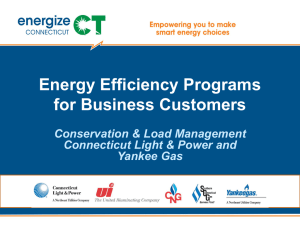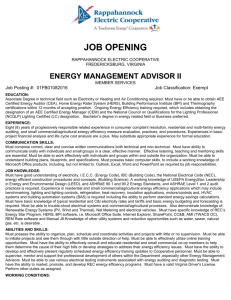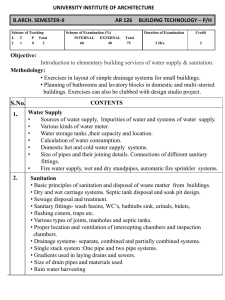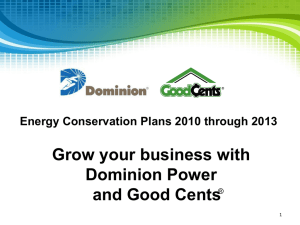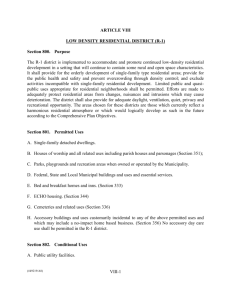Cities
advertisement
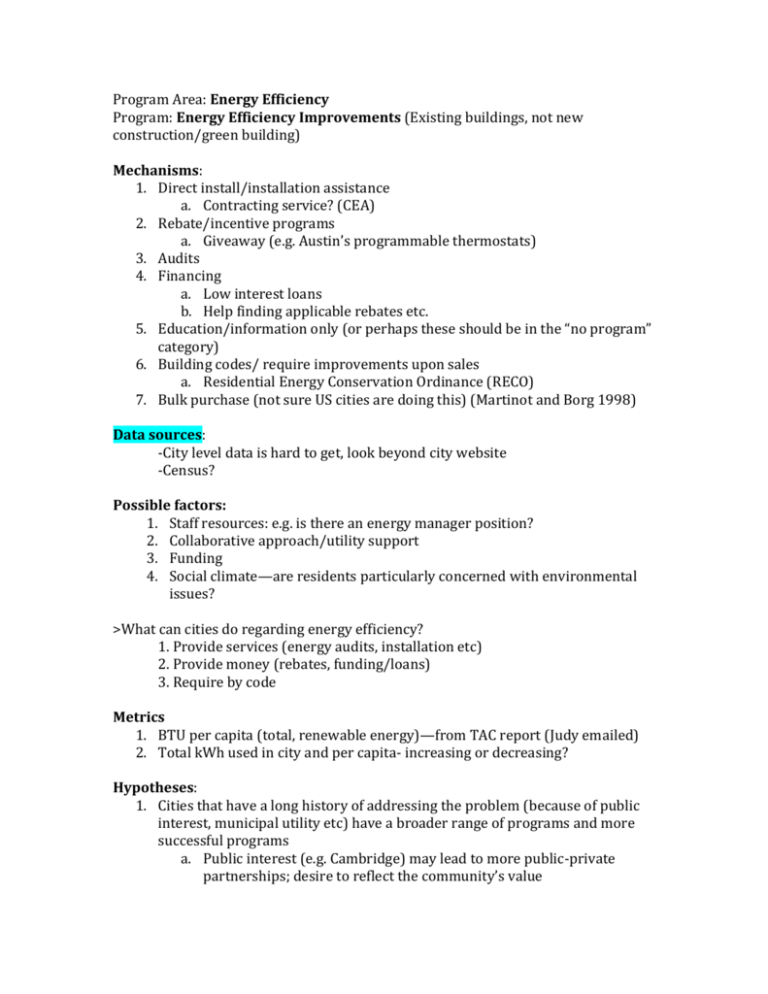
Program Area: Energy Efficiency Program: Energy Efficiency Improvements (Existing buildings, not new construction/green building) Mechanisms: 1. Direct install/installation assistance a. Contracting service? (CEA) 2. Rebate/incentive programs a. Giveaway (e.g. Austin’s programmable thermostats) 3. Audits 4. Financing a. Low interest loans b. Help finding applicable rebates etc. 5. Education/information only (or perhaps these should be in the “no program” category) 6. Building codes/ require improvements upon sales a. Residential Energy Conservation Ordinance (RECO) 7. Bulk purchase (not sure US cities are doing this) (Martinot and Borg 1998) Data sources: -City level data is hard to get, look beyond city website -Census? Possible factors: 1. Staff resources: e.g. is there an energy manager position? 2. Collaborative approach/utility support 3. Funding 4. Social climate—are residents particularly concerned with environmental issues? >What can cities do regarding energy efficiency? 1. Provide services (energy audits, installation etc) 2. Provide money (rebates, funding/loans) 3. Require by code Metrics 1. BTU per capita (total, renewable energy)—from TAC report (Judy emailed) 2. Total kWh used in city and per capita- increasing or decreasing? Hypotheses: 1. Cities that have a long history of addressing the problem (because of public interest, municipal utility etc) have a broader range of programs and more successful programs a. Public interest (e.g. Cambridge) may lead to more public-private partnerships; desire to reflect the community’s value 2. Cities that connect to national programs (e.g. Energy Star, ICLEI) will have more successful programs a. Pressure from above (e.g. national mayor organizations like http://www.usmayors.org/ focusing on climate change) 3. Relation to climate? Hotter cities might have more emphasis on energy, particularly on demand response 4. Role of the champion a. Particularly mayors with bigger political ambitions? (e.g. Villaragosa getting national attention for his Green LA) b. Structure of government, e.g. strong mayor system Inputs: -Financial (money for staff, advertising, rebates, loan programs etc.) -Organizational (staff/labor, materials, website...) -Technical resources (auditors, ee experts, tools...) -Connections to other organizations (e.g. Energy Star, utility companies, Clinton Foundation) -Political climate/context -Historical (?) Outputs: -Audit services -Rebates -Financing options (e.g. low/no interest loans) -? Outcomes: Primary: Energy savings Secondary: -Money savings -GHG reduction -New policies (?) -New regulation (in case of RECO and energy codes) Cities Ann Arbor, Michigan -Clinton Climate Change Initiative, C40 cities -Energy Fund: ongoing and self-funding (from CCI) $500,000 allocation over five years. This came from a10-year energy efficiency bond paid off in 1998, when the City chose not to eliminate the bond payment line item in the annual budget but rather to reduce it by 50% to $100,000 for the next five years. This money was then used to finance the new Municipal Energy Fund. -1981 city energy plan called for efficiency in municipal buildings - In July 1996, the City became a partner in the EPA’s Green Lights program, committing it an efficiency survey all 100 buildings and facilities, and an upgrade 90% of the lighting that was identified as inefficient. - Over the nine-year period, it has invested in: LED traffic and pedestrian signals street light improvements parking garage lighting a boiler two electric vehicles solar energy demonstration projects Ann Arbor has maintained an active Energy Office for over ten years, with an ongoing mission to improve energy efficiency at City facilities. This means that many of the best energy saving opportunities were already implemented before the creation of the Municipal Energy Fund. -Most projects have a payback of about 3 years > fund is quickly regenerated LED Streetlighting -The City of Ann Arbor paid $1.5 million to operate traffic signals and streetlights in FY2008. The cost would have been higher had the City not begun replacing incandescent traffic signals and pedestrian crossing signals with LEDs back in 2000. The replacements made so far are saving the city $49,000 annually, but the bigger savings opportunities are in street lighting, which accounts for 92 percent of that $1.5 million annual cost. Ann Arbor is currently investigating LED street lighting in the hopes of cutting our street lighting bill in half. After successfully piloting LED globe lights (below right) on a full block downtown, we are going ahead with full conversion of our over 1,000 downtown streetlights. $630,000 to fund the retrofit project is being provided by the Ann Arbor Downtown Development Authority. Energy Challenge Awards Program: City recognizes businesses for ee and renewables -Two levels of recognition, for specific projects/reduction in energy use From city website: “Ann Arbor has long believed that local government plays an important role in protecting the environment.” -Energy Plan updated in 1994 (should read more about this version) Austin, Texas -Municipal utility (Austin Energy): http://www.austinenergy.com/Energy%20Efficiency/Programs/Rebates/Residenti al/Home%20Performance%20with%20Energy%20Star/index.htm -Power Saver Program: A Home Performance with ENERGY STAR® Rebate covers up to 20% of the cost of certain improvements—up to $1575. We offer rebates on these improvements: Air conditioner or heat pump (14 SEER/11.5 EER or greater) Duct repair and sealing Additional attic insulation Solar screens, window film, and Low-E glass Caulking and weather stripping Attic radiant barrier/reflective material -Austin Energy’s energy efficiency programs and offerings date back to 1982. Combined, they have saved more electricity than the annual output of a 500 megawatt power plant. A 500 megawatt power plant can power 50,000 homes. -Qualifications: The residence must be a single-family home, mobile home, or duplex Homes with an appraised value of more than $150,000 (excluding land value) might be ineligible -Free programmable thermostats (As a Power Partner, you'll receive a free programmable thermostat plus free installation and warranty. This package is a $200 to $280 value.) -Power saver volunteers: get residential customers to sign up, they get a home kit, then get contacted 10x per summer to reduce peak demand (use less between 3pm and 7pm) As a thank you for becoming a Power Saver Volunteer, we'll send you a free Home Weatherization kit, including: Weather stripping Outlet sealers Two compact fluorescent bulbs (CFLs) An energy saver nightlight -City Energy Efficiency ordinance- houses must have audit before sale Commercial: rebates, free programmable thermostats, load profiler (energy use monitoring), peak demand, weatherization for multi-family -LEDs: In December 2007, the City of Austin and Austin Energy retrofitted a floor of the One Texas Center Parking Garage with 47-watt LED fixtures from Beta LED™. LED fixtures have also been installed in a hallway at Austin Energy headquarters, in streetlights on Barton Springs, in the Palmer Events Center marquee sign and in the water fountain at the new Palmer Events Center Park. Additional test installations are planned throughout the City, including a portion of the lights surrounding the Lady Bird Lake Hike and Bike Trail. These installations demonstrate Austin Energy’s significant commitment to installing high-quality, energy-efficient LED lighting throughout the City. From Patrick’s spreadsheet: Require disclosure of historic energy use and cost-effective energy efficiency improvements upon the sale of all buildings Boston, Massachusetts -Creating the Boston Energy Alliance (mentioned in the climate action plan, but can’t find)- Menino announced in January 2008 (I think this must have been supplanted by Renew Boston?) -Educational programs for residents online: Libraries have a kilowatt for rent, educational resources (info sheet) on website *Renew Boston Brad Swing, Director of Energy Policy, City of Boston, MA: “Renew Boston” - June 24, 2009 - (RealEstateRama) — In the third of four major announcements this week to advance the City’s green agenda, Mayor Thomas M. Menino today launched the $200,000 Renew Boston Residential Energy Efficiency Pilot Program in partnership with Next Step Living, Inc -Initial pilot funding will retrofit 150 Boston homes- free audits, 20% of these homes will be funded up to $2,000 for retrofits -$6.5 million from Federal Block Grants - The Renew Boston Residential Energy Efficiency Pilot will serve residents between 60-120 percent of the median income. The pilot program will coordinate closely with the City’s Department of Neighborhood Development and Action for Boston Community Development’s (ABCD) existing residential weatherization programs to reach residents between 0-60 percent of the median income -The Low Income Home Energy Assistance Program (LIHEAP) provides eligible households with help in paying winter heating bills. The program pays benefits of fixed amounts based on household income and size. LIHEAP operates between November 1st and April 30th, offering financial assistance to residents who are at or below 200% of the federal poverty level. No energy efficiency mentioned. Brad Swing’s Presentation to NEEC: -Emphasis on job creation -Planning on increasing funding from 2010 to 2012 -Includes non-residential 2008 Order from Menino to green municipal operations, mostly purchasing and recycling, sets up committee that includes “green information technology roadmap”, but no building retrofits -Nstar offers residential audits April 2010-“Sparking Boston’s Climate Revolution” March 2010- The city of Boston reports Boston Housing Authority buildings will receive $63 million in energy efficiency improvements. Chicago -Residential weatherization in climate action plan -From website: Retrofit residential buildings: Improve efficiency of 50 percent of residential buildings to achieve a 30 percent reduction in energy used = 1.44 MMTCO2e reduction*” -Current program: Bungalow Initiative (http://www.chicagobungalow.org): retrofitting bungalow style homes (historic presevation too) Under the expanded Bungalow energy$avers Blocks Program, a group of homeowners can apply for grants to cover most of their energy-efficiency needs including insulation, new heating systems, as well as hot water heaters, the replacement of doors and windows, and installation of water-saving devices such as low flow faucets and shower heads, and dual flush toilets. -Educational materials on website: “$800 Challenge” -Part of Clinton Climate Change C40 Cities (http://www.c40cities.org/cities/) -From Patrick: Improve EE at 50% of R buildings, 30% energy reduction Cambridge -Joined ICLEI in 1999 Cambridge Energy Alliance-Launched On March 29, 2007; city-sponsored organization- works with all sectors Residential programs: -Audit (Working with energy efficiency professionals, we help you replace inefficient appliances, lighting, and heating/cooling equipment, insulate your building, and identify other ways to save) -They have a scale of audit options: basic free audit (through MassSAVE, a utility program), fee for thermal imaging (through Next Step Living), low-income weatherization -Financing and rebates -Contracting services (direct install?) -Program goal: CEA’s goal is to reduce energy use in the City of Cambridge by an average of 10% and about 15% (50 MW) of peak use, within the next few years by promoting the adoption of energy efficiency technologies and behaviors. Presentation: lead by example Cambridge has won awards… Municipal: The City Manager has established an Energy Management Workgroup to systematically assess City owned facilities and identify energy efficiency upgrade projects. The workgroup, chaired by the Public Works Department, is working with the federal government’s Energy Star Benchmarking Portfolio Tool and with NSTAR’s energy efficiency consultants. (link) -First benchmark was in 2006 GreenSense: hired consultant to train employees (turn off lights, computers etc) tracked energy use— reduced by about 10% Climate Action Plan -In 2000, 101,355 residents occupied 41,320 units, (2.45 people/unit) -Estimated 12% reduction in energy use through cost effective efficiency -Prioritizing retrofitting buildings -Cambridge Housing Authority: Cambridge Housing Authority has saved 3,032,587 kwh of electricity and 113,566 therms of natural gas since 1995 through a variety of energy saving actions. Denver -Plan to use stimulus money for weatherization and audits/retrofits in city buildings -Focus on money savings and environment (equally?) -Energy Management System (EMS)- partnership with state? EPA influence? -Denver Energy Challenge (city, Xcel, Sierra Club): customers can sign up for renewable energy > Xcel donates to schools > ee or renewables at schools -Denver receives $2.1 million/year from the Xcel Energy Franchise > funds administered through DOSP support energy assistance programs and services for low-income individuals and nonprofit agencies for the next 20 years. -Nonprofit Energy Efficiency Program (NEEP): joint city, Xcel and DOSP venture > ee for non-profits (e.g. homeless shelters) Purchasing policy (doc in folder): mostly not about ee, but include energy star products Detroit, MI -New mayor- Ken Cockrel- started Office of Energy and Sustainability (green collar jobs) in early 2009 (but he’s no longer mayor, not clear if anything actually happening) -Plans to evaluate the ee of city buildings -Stimulus money -Weatherization for homes Houston, Texas -Part of Clinton Climate Change C40 Cities (http://www.c40cities.org/cities/) -see spreadsheet http://www.houstonpowertopeople.com/proven.html http://www.eco-structure.com/energy-efficiency/houston-commits-23-million-to-energy-efficientretrofits.aspx The city of Houston, Texas, has launched a $23 million project to improve the energy efficiency of 19 city facilities as part of the city's participation in the Clinton Climate Initiative Energy Efficiency Building Retrofit Program. Schneider Electric will complete the work under a performance contract with the city and the company guarantees that Houston will save $1.8 million annually over the 15-year contract. Kansas City, Missouri Patrick: Expand home weatherization program -Using stimulus money for energy efficiency -Utility (Kansas City Power and Light, IOU) seems to have residential programs Kansas City, Kansas -Public utility, Kansas City Board of Public Utilities serves part of city -Information for homeowners on website (educational only) -State energy efficiency loan program -Rebates- mostly AC and heat pumps -Advertise DOE weatherization program Los Angeles Patrick: Increase the level and types of customer rebates for energy efficient appliances, windows, lighting, and heating and cooling systems. -City: no programs outside of LADWP -Executive order July 2007 (Sustainable Buildings), which calls for reducing municipal energy use to fullest extent possible -Green LA program to address climate change (beyond Kyoto requirements, focus on clean energy) -LED green traffic lights, with Clinton Foundation -CFL giveaway- through LADWP (2 bulbs to all 1.2 million households -projected to save up to 240 gigawatt-hours of energy and 131,000 metric tons of CO2 each year – the equivalent of taking 24,000 cars off the road or enough energy to power 40,000 homes for a year. -Part of Clinton Climate Change C40 Cities (http://www.c40cities.org/cities/) -LA Department of Public Works, Bureau of Street Lighting has done LED street lighting demo projects -LADWP: -On city website: emphasizes residential refrigerator rebate and commercial direct install and rebates -The Consumer Rebate Program offers rebates for refrigerators, pool pumps, dual pane windows, air conditioners, and clothes washers. -CFL distribution program -The REfrigerator Turn-In and REcycle (RETIRE) program offers rebates for old qualifying refrigerators. Low-income Refrigerator Exchange: LADWP provided 13,650 free Energy Star-rated refrigerators in exchange for old, inefficient models in 2008-09, -Online home audit tool—link to LBNL tool (DIY) Five core programs accounted for 92 percent of LADWP’s energy savings during fiscal year 2008-09, including (link): 1. Compact Fluorescent Lamp (CFL) Distribution: LADWP delivered 2.4 million CFLs-two CFLs to each of the 1.2 million residences in Los Angeles. • Energy savings: 121 GWh; reduces 68,000 metric tons of GHG emissions annually. • Utility bill savings: $16-$20 per year; approximately $100 over life of the CFLs. 2. Low-income Refrigerator Exchange: LADWP provided 13,650 free Energy Star-rated refrigerators in exchange for old, inefficient models in 2008-09, and 45,000 since the program’s inception in 2006-07, to qualified low-income customers. Saving energy and money, the program takes the inefficient refrigerators off the grid, and ensures they are environmentally recycled. • Energy savings: 11 GWh; reduces about 6,200 metric tons of GHG emissions annually. 3. Small Business Direct Install: LADWP installed free energy efficient lighting for more than 34,000 small businesses in 2008-09. The program targets businesses using less than 30 kWh. • Energy savings: 100 GWh; reduces 56,000 metric tons of GHG emissions annually. • Utility bill savings: As much as $500 per year, a 25 percent bill reduction. 3. Commercial Lighting Efficiency Offer: More than 500 rebates for high efficiency lighting projects were paid to commercial, industrial and governmental customers, totaling $4.75 million, in 2008-09. • Energy savings: 36 GWh; reduces more than 20,000 metric tons of GHG emissions annually. • Utility bill savings: Approximately $3.9 million for program participants collectively. 4. Custom Performance Program: LADWP paid $2.7 million in incentives to non-residential customers for 77 energy efficiency projects in 2008-09. The program provides incentives for energy efficiency measures not covered by other energy efficiency programs. • Energy savings: 26.5 GWh; reducing almost 15,000 metric tons of GHG emissions annually. • Utility bill savings: Approximately $2.9 million for program participants collectively. 5. Consumer Rebate Program: LADWP residential customers received rebate payments totaling $1.1 million in 2008-09 for energy saving refrigerators, pool pumps and motors, dual pane windows, and air conditioner equipment. An additional $364,000 was paid to customers through the refrigerator "RETIRE" program, which offers a $35 cash incentive to customers resulting in LADWP picking up customers’ older, inefficient refrigerators and recycling them in an environmentally responsible manner. • Energy savings: 10 GWh; reducing 5,600 metric tons of GHG emissions annually. • Utility bill savings: Approximately $1.2 million for program participants collectively. Milwaukee, MI -Private investment capital for energy efficiency, Milwaukee Energy Efficiency estimates that planning and implementation costs for a third party efficiency investment program to be $500,000. -Milwaukee Energy Efficiency (ME2): project of Center on Wisconsin Strategy (COWS) started in fall 2007 -Project with city? -Goal to improve efficiency of building stock; funding mechanism: building owner pays back cost of efficiency through municipal services or utility bill on schedule that yields immediate savings (emphasis on cost savings and green jobs) -Using stimulus money for building retrofits -LED traffic lights cause more traffic in winter (snow doesn’t melt)? -Milwaukee Office of Sustainability created by Mayor Barrett in 2004 -Mayor Barrett signed US Mayor’s Climate Protection Agreement New York, NY -PlaNYC: mayor’s environmental initiative -Plan for building efficiency codes- all buildings over a certain size will require audits (taking effect in 2013, funding to get business started earlier) every decade and implement cost-effective measures (payback <5 years) >> canceled… -Established a New York City Energy Policy Board -Wants to commit 10% of the city budget to energy efficiency (should start to break even by 2013) -GreeNYC: public awareness campaign (unplug, use CFLs etc) -Part of Clinton Climate Change C40 Cities (http://www.c40cities.org/cities/); which includes funding sources (banks part of coalition) -Oct. 2007-Executive Order 109: city agencies responsible for energy efficiency measures, set up a steering committee NY Housing Authority: energy efficiency in city-owned housing facilities Philadelphia -Part of Clinton Climate Change C40 Cities (http://www.c40cities.org/cities/) -Almost all action is around stimulus? Pittsburg -Stimulus for municipal audits and retrofits -Nothing until stimulus Portland http://www.portlandonline.com/bps/index.cfm?a=116779&c=41462 http://www.cleanenergyworksportland.org/ -Clean Energy Works: http://www.cleanenergyworksportland.org/ -Home retrofits (partnership with utilities and other organizations)- audits followed by help with retrofits (“energy advocate”) and financing (no upfront cost, money is taken out of future utility bills) -Pilot of 500 homes, 30 homes have been selected to participate in the early phase of this pilot, which began in June and concludes at the end of August 2009. -ARRA funding -Part of Northwest Energy Efficiency Alliance (NEEA) -City Energy Policy- 1979, updated 1990 -“ The 1990 Energy Policy included 89 objectives in goal areas including City operations, energy efficiency in residential, commercial and industrial facilities, transportation, telecommunications, energy supply, waste reduction and recycling.” – from city website By 2000, more than 90 percent of the objectives in the plan have been achieved, including such highlights as: City energy bills were reduced by $1.1 million annually for a total reduction of more than $7 million. Technical and financial assistance programs and awards offered by the state, city and utilities for businesses and property owners resulting in energy efficiency improvements in more than 40 million square feet of commercial and institutional space. More than 22,000 apartment units weatherized through joint efforts among the City and local utilities. A nine percent reduction in per capita household energy use. New commercial and residential state energy codes. (http://www.portlandonline.com/bps/index.cfm?a=116779&c=41462) -LED Traffic Lights The Office of Transportation has replaced all red and green traffic signal incandescent light bulbs with energy saving light emitting diode modules (LEDs). The LED modules reduce energy use about 85 percent over standard light bulbs and greatly reduce yearly maintenance. By installing 14,000 LED lamps, the City saves approximately 5.25 million kWh each year – enough to power over 400 homes. San Francisco, CA Patrick: Increase incentives, direct installation and technical assistance (w specific goals) -All activities seems to be through SF Department of the Environment (SFE) or SFPUC -SF Energy Watch: multi-family and commercial (audits and rebates) -Save Energy at Home: information with links to resources (PG&E, SFPUC, Energy Star) Residential Energy Conservation Ordinance (RECO): Time of sale spending cap of $1,300 is invested in energy efficiency improvement at every property transfer RECO-compliant homes are 10 percent more efficient than an average San Francisco home life cycle of energy efficiency improvements is 10 years -Established 1989, requires owners to do an energy audit and install certain measures, then file an inspection report with the Department of Building Inspection -Only for homes built before 1978 and only need to do once LEDs: partnership with SFPUC and PG&E Municipal Retrofits: -City Hall: daylighting, HVAC and solar -Recent retrofit projects include the Moscone Convention Center Energy Project (lighting and controls 800 kW peak savings), SF General Hospital Lighting project (700 kW peak savings), and current projects at powerhouses and cottages at Moccasin as well as SF General Hospital central plant. A typical project cycle is approximately three years for planning, development, construction and activation. The investment in efficiency projects can be recovered quickly, often in less than five years. Seattle Climate action goal: increasing the efficiency of Seattle buildings by at least 20 percent by 2020 Seattle City Light = muni Residential: -Twist and Safe- CFL distribution -Reduced cost audits -Rebates Commercial: -Programs for small, large and industrial -Includes rebates and assistance Office of Housing: http://www.seattle.gov/housing/HomeWise/ -Low income weatherization program, includes 3% interest loan -Climate Action Now: distributed home energy kits (can’t find info on this) http://www.seattle.gov/mayor/newsdetail.asp?ID=10497&dept=48 -The Energy Disclosure Ordinance: large commercial and multi-family property owners must annually measure, or benchmark, their energy use and provide city with ratings -Building owners also required to show energy usage data with prospective buyers, tenants and lenders -This alone will not save energy, but City Councel Chair Richard Conline thinks this is the first step “you can’t manage what you don’t measure” Babylon, NY -Long Island Green Homes Program: residential retrofits financed at zero upfront costs, money is taken out of their utility bills (plus a 3% admin cost) -Funding from city’s solid waste fund -Part of Climate Protection and Sustainability Plan -Financing goes with house, even if occupant moves (cost recovered through city taxes) Chattanooga, TN Climate Action Plan: -Lights out at night -Lighting (reduce amount of time that streetlights are on, change to more efficient lights, lighting retrofits and occupancy sensors for government and for community) Chattanooga Green Lodging (http://www.chattanoogagreenlodging.com/) -Includes energy efficiency: CFLs, LED exit signs, lighting sensors, efficient heating and cooling, Energy Star office equipment Housing Authority partnered with Honeywell to do energy and water retrofits in 18 public housing sites (http://www.allbusiness.com/environment-naturalresources/pollution-environmental/5127892-1.html) -2005 -Electricity saved: 11 million kilowatt-hours, The amount of electricity saved could power more than 1,000 homes on average per year. -$10million performance contract Boulder, CO http://online.wsj.com/article/SB100014240527487043201045750159209928453 34.html#project%3DGREENER1209%26articleTabs%3Darticle -Started in 2006 to make Boulder a role model in reducing GHG, but have found it more difficult than thought -In 2010 will be replacing incandescents with CFLs -“But Boulder has found that financial incentives and an intense publicity campaign aren't enough to spur most homeowners to action, even in a city so environmentally conscious that the college football stadium won't sell potato chips because the packaging isn't recyclable.” -Since 2006, Boulder has subsidized about 750 home energy audits. Even after the subsidy, the audits cost each homeowner up to $200, so only the most committed signed up. Still, follow-up surveys found half didn't implement even the simplest recommendations, despite incentives such as discounts on energyefficient bulbs and rebates for attic insulation. -~75 businesses got free audits—made so few of the recommended changes on 1/5 of the estimated wasted energy was actually saved -In 2006, Boulder voters approved the nation's first "carbon tax," now $21 a year per household, to fund energy-conservation programs. But Boulder's carbon emissions edged down less than 1% from 2006 through 2008, the most recent data available. -Boulder plans to spend about $1.5 million in city funds and $370,000 in federal stimulus money to hire contractors to do basic upgrades for residents. -"Two Techs in a Truck," as many as 15 energy-efficiency teams will go door-todoor. They'll ask home and business owners for permission to caulk windows, change bulbs and install low-flow showerheads and programmable thermostats— all at taxpayer expense. -The city aims to overcome public inertia with a fresh advertising approach. Instead of talking about environmental benefits, new promotions will focus on financial benefits: Save energy, save money. In 2006, the city organization used over 26 million kilowatt hours of electricity and 700,000 therms of natural gas, emitting almost 20,000 mtCO2. http://www.bouldercolorado.gov/index.php?option=com_content&view=arti cle&id=7715&Itemid=2851 Boulder has handed out over 3,000 CFLs since January 2004. (Climate Action Plan) http://www.conservationcenter.org/Energy_Audit_Program.htm Boulder’s ClimateSmart Residential Energy Action Program -Subsidized audits ($90)- customers receive audit with blower door, utility bill review, assistance with rebate forms, information about loan programs The Facilities and Asset Management (FAM) Division It is FAM's general policy to complete energy-saving projects that have a five year or less payback and purchase Since 2000, FAM has completed over $2 million worth of energy efficiency improvements in city facilities. These improvements included replacement of old HVAC units with newer more efficient units, additional insulation, and window replacement. FAM is actively pursuing methods to reduce energy costs as many departments are struggling meeting the increasing costs of energy. http://www.bouldercolorado.gov/index.php?option=com_content&task=view &id=9988&Itemid=2092 Climate Action Plan -The city has handed out over 3,000 CFLs since January 2004. -Goals to Retrofit existing buildings and replace appliances to improve energy efficiency and promote energy-conserving behavior. (CAP Guide p 8) -2006-2008 accomplishments (CAP Guide p 14): • Encouraged the community to take voluntary action to conserve and improve energy efficiency by communicating the potential cost savings and environmental benefits. • Provided financial incentives for selected efficiency improvements. • Leveraged incentive programs provided by other entities. Reduced community emissions by approximately 6,700 tons CO2e in 2008 through CAP energy efficiency programs. Energy Audits: 750 single family homes 30 multi-family residential buildings 75 businesses Insulation Rebates: 106 households Conservation Kits: 550 households CFL & LED Bulbs: 34,000 compact fluorescent light bulbs (CFL) distributed or discounted 3,700 incandescent holiday lights exchanged for LED light coupons 10 for Change: 45 businesses committed to reducing their energy use by 10 percent Other: 10 neighborhood climate action groups received CAP assistance http://beclimatesmart.com/about/ Climate Smart: -City and County joint program -“education, financial incentives and services not available elsewhere to help people make energy efficiency and renewable energy improvements to their homes and commercial buildings.” -Homes: about 17% of city’s energy use, energy audits and weatherization, rebates from Xcel, loan program -Businesses: most through Xcel, plus loan program and competition (10 for change) http://www.10forchange.net/ 10 for Change -Volunteer program—challenge to businesses to reduce energy use by 10% -Cosponsored: Hogan & Hartson, Cleantech Solutions and the city of Boulder -Register, establish baseline, then program helps you measure your energy use -Has recommendations, 5 energy end use for different sectors -Success story: 19% reduction in energy use (more efficient HVAC unit and controls, lighting controls- motion sensors and timers) -Over 50 business participating -Also includes monthly breakfast meetings to exchange information/ network http://www.bouldercolorado.gov/index.php?option=com_content&view=article&id =11637&Itemid=4180 Also considering a Commercial Energy Conservation Ordinance (CECO) in 2010 Jacksonville, Florida Office of Sustainability Initiatives -Sept. 2008 -Received $250,000 from ARRA block grants, plan to do stuff, but not clear what -Municipal retrofits: Godbold City Hall Annex: LEED-ED, included efficient lighting, cool roof City staff established "set points" for heating and air conditioning in city-owned facilities to what is believed to be a “standard”; that is 68 and 78 degrees, with a one or two degree deviation allowable Sustainable Building Program- standards for public buildings and incentives for private green building (like fast tracking) CFLs- coupons at retail locations Other rebates: http://www.jea.com/community/stories/productrebates.asp Minneapolis, MN http://www.ci.minneapolis.mn.us/recovery/c-cat_Energy_and_Environment.asp -Planned with stimulus: financing programs for business and residential, municipal building energy audits http://www.huduser.org/periodicals/fieldworks/0600/fworks3.html Minneapolis Public Housing Authority (MPHA) updated HVAC, water and sewer systems in 40 high rise developments ($3.2 million bond) -18 months saved $214,000 in electricity costs in 5,000 units Living Well Report 2009 The City tested energy-saving, light-emitting-diode (LED) streetlights for use citywide, installed energyefficient lighting at the Hilton Parking Ramp and installed a high-efficiency boiler at Parking Ramp A. 2005 Sustainability Plan: talks about CO2 reduction and renewables but nothing (nothing!) on efficiency 2007 Living Well: city buildings must be LEED, tested use of LED stringlights for holiday decorations 2008 Living Well: hired an energy manager, The Minnesota Energy Challenge now has more than 2,500 Minneapolis businesses and residents pledging to reduce carbon dioxide emissions compared to 700 in 2006. State: Minnesota Energy Challenge (http://www.mnenergychallenge.org/) Salt Lake City, UT -Emphasis on new construction (reduce footprint by 50%), high performance building codes http://www.slcgov.com/slcgreen/energy/slcBlueprint.htm Energy Blueprint: framework for sustainable energy -Energy demand is growing—between 2002 and 2007 total consumption grew 5%, household use up 7%, total customers only up 2% -Utility rebate programs (Rocky Mountain Power and Questar) -Goals: to reduce city government building energy use by 20% from 2007 baseline by 2020, and 50% street lighting from 2005 to 2010 -EMS planned -Update energy efficiency ordinances by end of 2010 -Goal to reduce residential and business energy use by 10% through education -City purchasing plan http://www.slcgov.com/slcgreen/energy/eecbg.htm -Block grants: $2.165 million dollars -Loan fund ($479k)—e2-RLF for businesses planning for 2010, low interest loan, payback terms to match energy savings -Energy code ($172k) -Outdoor lighting (street and traffic) to LEDs ($213k) http://www.slcgov.com/slcgreen/code/ Code—planning revisions http://www.slcgov.com/slcgreen/energy/energySaving.htm Municipal Retrofits: -Updates to lighting and building systems since 2001 > 840,000 kWh/ year savings -Airport: efficiency upgrades (5,200 lights, 800 occupancy sensors) > 1.5million kWh, $70,000/year -Cool roof on parks department building -Traffic signals—all green and red to LED (1,700,000 kwh and $100,000 per year), will start yellow in 2010 and start street lights (long term project) -Working with an ESCO San Diego, CA -Energy Conservation & Management Division- formed in response to 2001 energy crisis http://www.sandiego.gov/environmentalservices/energy/programsprojects/saving/retrofits.shtml -90 percent of the City's 1,486 signaled intersections to energy-efficient light emitting diode (LED) lamps -Each year, these LEDs reduce energy use by 13,212 megawatt-hours, eliminate 7,437 tons of greenhouse gases, and save the City $1.3 million (funded by utility) The City avoids more than $250,000 in energy costs each year after the Central Library, World Trade Center, Pump Station #2 and the Crabtree Building received retrofits of energy-efficient equipment, including: A lighting retrofit at the Crabtree Building and Metropolitan Wastewater Department's Pump Station #2. A large ventilation fan and filter installed in Pump Station #2. Variable speed drives on pumps and motors and high-efficiency water chillers for the air conditioners installed in the Central Library and World Trade Center. Lighting upgrades to install T-8 lamps in 75 libraries and Park and Recreation facilities save 50% of the energy used by the old T-12 lamps. -Annual energy savings to fund energy-efficiency updates to the Police Headquarters -Efficiency upgrades funded by the state Need to add… Santa Monica, CA -Leave all residential and commercial rebates to utility City has sustainability plan, updates and report cards http://www.smgov.net/Departments/OSE/Categories/Sustainability/Sustainable_C ity_Progress_Report/Resource_Conservation/Energy_Use.aspx - Energy conservation measures have been successful and energy use in the city remains stable, despite expected increases in resource usage associated with Santa Monica’s strong economy and growth in construction activity. http://www01.smgov.net/cityclerk/council/agendas/2006/20060314/s20060314 08-B.htm Report cards (see documents folder): have a “Resource Conservation” category, but not much emphasis on ee 1999 Progress Report -100% renewable power for city facilities, all facilities retrofitted to improve efficiency -Lease-purchase agreement ($1.6 million) with SCE’s ENVEST program- retrofit (lighting, HVAC, energy control systems) > 12 year payback -Phase 1 = 6 buildings and 6 parking structures completed in 1996 -Phase 2 = 9 buildings and public beach bathrooms completed in 1998 -Traffic signals- planned for 1999-2000 Procurement Policy Administrative Instruction for the Purchase of Energy-Efficient Office Equipment In September 1998 staff in the Environmental Programs, Purchasing and Information Systems divisions completed an administrative instruction that applies to all City employees who purchase, lease or use office equipment. The policy instructs these employees to purchase energy-efficient office equipment and identifies ways to use the equipment in the most energy-efficient manner possible. The policy requires that all computer processing units, monitors, printers, scanners, fax machines, copiers, and multi-function devices purchased or leased by the City shall, at a minimum, meet the energy efficiency standards established by the U.S. EPA’s Energy Star program. Washington DC - Washington, D.C., went further in 2008 by requiring phased-in public disclosure of energy use starting this year The Clean and Affordable Energy Act of 2008 (CAEA) requires the Mayor, through DDOE, to contract with a private entity to conduct sustainable energy programs on behalf of the District of Columbia. Sustainable Energy Utility (SEU)—one stop resource for efficiency and renewables -Have PEPCO as distribution utility District Department of the Environment—Energy http://ddoe.dc.gov/ddoe/cwp/view,a,1209,q,493706,ddoeNav_GID,1478,ddoeNav,| 31424|.asp Energy Assistance: -Funded by US Department of Health and Human Services, the District Government, and the Reliable Energy Trust Fund. http://ddoe.dc.gov/ddoe/cwp/view,a,1209,q,492761.asp -Free audits for single family homes -Replace window AC and refrigerators (only low income) -Weatherization (weather stripping, insulation, bulbs, HVAC repair) for low income Green Building Act of 2006 http://energydisclosure.com/index.php/mandatory-energy-disclosure-washingtond-c/ -2010 building ratings for 200,000 sq ft or more, decreasing 50,000 each year until floor of 50,000 sq ft -Must disclose independent of transaction, available to public Other Information Who Should Run Programs? -US electricity restructuring > EPAct ’92 encouraged utilities to conduct Integrated Resource Planning- consider costs and benefits to society, including using efficiency as way to meet supply needs -Typically resource acquisition programs: customers provided with technical assistance and/or financial incentives to invest in energy-efficient building materials or products -EPACT also contained provisions for restructuring, generally with restructuring, less incentive to pursue resource acquisition programs -New strategy: Market transformation; goal is to transform market for energy efficiency products, not immediate savings -Restructuring also calls into question method -Pre-restructuring: utilities are vertical monopolies, regulators can just order them to have programs and include program costs in utilities’ rates -After: separate charge (e.g. public benefit fund) on the bill from the monopoly distribution utility -State and regional differences in utility structure and regulation Administrative options: -Before restructuring- utilities were responsible, overseen by state regulators -Some restructured states have alternative approaches, program administration by state agencies or by non-profits -Utilities are multi-purpose organization (have incentive to sell electricity), but have economies of scale, right scope -State agencies are also multi-purpose, may have difficulty focusing on new mission, political pressures -Non-profit: single purpose, but new organization -There can also be partnerships or private companies as consultants Criteria for selecting an administrator: 1. Compatibility with public policy goals (usually set at the state level) 2. Effectiveness of incentive structure (typical structure includes shareholder benefit for efficiency programs, market transformation programs are more difficult) 3. Economies of scale and scope (no huge economies of scale for resource acquisition programs, but market transformation needs to have large impact) 4. Contribution to EE infrastructure (initial view that government intervention could be temporary; alternative view is that ee programs address externalities, should program administrator actually have staff to carry out programs or should they just be a funding source) (Blumstein, Charles et al. 2005) Barriers to Energy Efficiency -Belief in barriers justified continued government intervention -“Efficiency gap” between consumer’s actual investments and those that appear to be in their best interest -Market failures vs. market barriers (failures do not necessarily require govt intervention) -No single market for energy services, actually many end uses and intermediaries -Government intervention is not perfect, must be based on pragmatic assessment of limits of institution -Things change, policies need to be reviewed -Need to be specific about barriers and have sound understanding [Exec summary only, more info in paper, recounts specific market barriers] (Golove and Eto 1996) Bibliography Blumstein, C., G. Charles, et al. (2005). "Who should administer energy-efficiency programs?" Energy Policy 33(8): 1053-1067 Golove, W. H. and J. H. Eto (1996). "Market Barriers to Energy Efficiency: A Critical Reappraisal of the Rationale for Public Policies to Promote Energy Efficiency." LBL-38059. Martinot, E. and N. Borg (1998). "Energy-Efficient Lighting Programs: Experience and Lessons from Eight Countries." Energy Policy 26(14): 1071-1081. PlanNYC (2007). Inventory of New York City Greenhouse Gas Emissions New York, NY, Mayor’s Office of Operations, Office of Long-Term Planning and Sustainability
